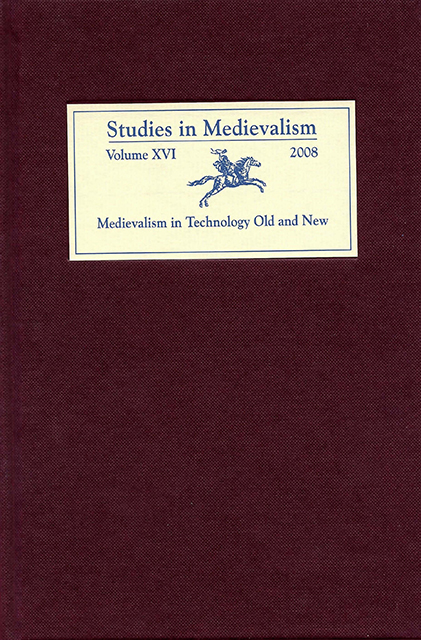Book contents
- Frontmatter
- Studies in Medievalism
- Acknowledgments
- Contents
- Volume XVI 2008
- Illustrations
- Editorial Note
- Contes du Style des Troubadours: The Memory of the Medieval in Seventeenth-Century French Fairy Tales
- A Ritual Failure: The Eglinton Tournament, the Victorian Medieval Revival, and Victorian Ritual Culture
- An Eastern Medieval Revival: Byzantine Art and Nineteenth-Century French Painting
- I Am Weary of That Foolish Tale: Yeatss Revision of Tennysons Idylls and Ideals in Time and the Witch Vivien
- The Doughboy Comes to Chartres: Stars and Stripes and the Middle Ages
- Constructing Difference: The Guidonian Hand and the Musical Space of Historical Others
- An Introduction to Medievalist Video Games
- Medieval and Pseudo-Medieval Elements in Computer Role-Playing Games: Use and Interactivity
- Romancing the Game: Magic, Writing, and the Feminine in Neverwinter Nights
- Revising the Future: The Medieval Self and the Sovereign Ethics of Empire in Star Wars: Knights of the Old Republic
- Promises of Monsters: The Rethinking of Gender in MMORPGs
- Contributors
Constructing Difference: The Guidonian Hand and the Musical Space of Historical Others
Published online by Cambridge University Press: 10 March 2023
- Frontmatter
- Studies in Medievalism
- Acknowledgments
- Contents
- Volume XVI 2008
- Illustrations
- Editorial Note
- Contes du Style des Troubadours: The Memory of the Medieval in Seventeenth-Century French Fairy Tales
- A Ritual Failure: The Eglinton Tournament, the Victorian Medieval Revival, and Victorian Ritual Culture
- An Eastern Medieval Revival: Byzantine Art and Nineteenth-Century French Painting
- I Am Weary of That Foolish Tale: Yeatss Revision of Tennysons Idylls and Ideals in Time and the Witch Vivien
- The Doughboy Comes to Chartres: Stars and Stripes and the Middle Ages
- Constructing Difference: The Guidonian Hand and the Musical Space of Historical Others
- An Introduction to Medievalist Video Games
- Medieval and Pseudo-Medieval Elements in Computer Role-Playing Games: Use and Interactivity
- Romancing the Game: Magic, Writing, and the Feminine in Neverwinter Nights
- Revising the Future: The Medieval Self and the Sovereign Ethics of Empire in Star Wars: Knights of the Old Republic
- Promises of Monsters: The Rethinking of Gender in MMORPGs
- Contributors
Summary
To reconstruct the pre-modern understanding of the fundamentals of music has been a preeminent occupation of music historians at least since Martin Gerbert published a major anthology of medieval music-theory writings in the late eighteenth century. The earliest comprehensive music histories by John Hawkins and Charles Burney already featured lengthy discussions of medieval and Renaissance conceptualizations of musical space (interval, scale, harmony, counterpoint, etc.). Later generations of scholars continued and expanded the systematic study of early musical treatises, de facto establishing a new musicological discipline – the history of music theory – that until roughly the mid-twentieth century aimed primarily at reconstructing the origin and the evolution of theWestern “tonal consciousness,” i.e., of the principles governing Western harmony and rhythm, and specifically the musical language of the Classical/Romantic era from, say, J. S. Bach to Gustav Mahler. From its inception the history of music theory has been inherently comparative in nature, and in this sense it recalls rather closely the history of anthropology. We have been studying the musical conceptualization of historical Others as a way of casting light on the modern ways of systematizing and categorizing musical sound. In many ways, and predictably, Latin music theory de-familiarizes us from our musical past as much as (and often at the same time as) it mediates that past and brings us closer to it.
The basic questions that guide the work of the historian change a great deal, of course. It is possible to observe a marked shift in the research program of the history of medieval and Renaissance music theory after World War II. Since then, in line with the pursuit of authentic recreations of early music in performance – a pursuit that occupied academics and performers through the 1980s – a good portion of Latin music theory has been directed at emphasizing the vast cognitive differences that separate the “modern” ways of parsing the materials of music (that modern “tonal consciousness”) from the “pre-modern” ones. Latin music theory has bequeathed to us valuable knowledge on how the materials of music were taught, classified, and reflected upon, thus in a sense experienced in a period of European cultural history that in recent musicological parlance has been portrayed as pre-modern far more frequently than as pre-modern.
- Type
- Chapter
- Information
- Studies in Medievalism XVIMedievalism in Technology Old and New, pp. 98 - 122Publisher: Boydell & BrewerPrint publication year: 2008
- 5
- Cited by

